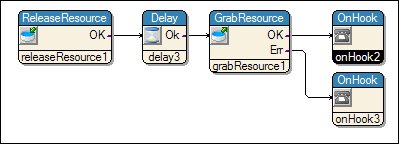
Delay control offers a silent mode that allows to temporarily park a call with no need for voice rescues, while still being able to detect and react to a disconnect. This mode, referred to as vbvDelayTypeSilentNoResource, is available only on the DM3 cards.
Many applications need voice resources only for a short period during a call. Calling card systems are a classic example of such applications. After a caller is authenticated, he is typically bridged with a second channel that connect to his destination. At this point, voice resources are not required any more and may be reused by the other channels. In consequence, the total number of resources in the system may be reduced, leading to a significant cost saving.
Application's code has a full control over how resources are being used. The Delay control is typically used to park the call while in a bridge. The ReleaseResource and GrabResource controls are used to manipulate the resources. In the example below, a ReleaseResource control is used to release the resource before entering a Delay control. The delay is set to vbvDelayTypeSilentNoResource mode and it also contains the code that sets up and tear down the bridge.

The Delay may be exited and reentered many times, which allows to, for example, play periodical announcements to the callers. Finally, once the bridge is disconnected, the GrabResource control has to be used once again, because the following OnHook control requires a resource to play the goodbye prompt.
NOTE: Although this mode does not need a voice resource, it is still capable of detecting call disconnect events.